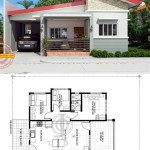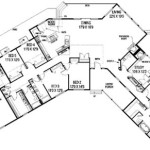How to Draw House Plans: A Comprehensive Guide
Drawing house plans is a fundamental skill for architects, builders, interior designers, and even homeowners looking to visualize their dream spaces. Whether for a small renovation or a complete new build, a well-drawn house plan provides a clear roadmap for the project. This document outlines the essential elements and steps involved in creating accurate and useful house plans.
The process of drawing house plans can range from simple hand-drawn sketches to sophisticated computer-aided design (CAD) models. The chosen method depends on the project's complexity, the required level of precision, and the resources available. This article presents a comprehensive overview of the key considerations and techniques for effectively drawing house plans for various purposes.
Understanding the Basics of House Plan Design
Before putting pencil to paper (or cursor to screen), it is crucial to grasp the fundamental principles that underpin effective house plan design. This involves not only understanding spatial relationships but also adhering to building codes and incorporating practical considerations for comfortable living.
First, consider the function of each room and how they relate to one another. A well-designed house plan optimizes flow and functionality. For example, the kitchen should ideally be located near the dining area, and bedrooms should be separated from noisy living spaces. Factor in traffic patterns to minimize unnecessary movement through the house. The relationship between indoor and outdoor spaces is also important; think about how natural light will enter the house and how outdoor areas will be accessed.
Adherence to local building codes is paramount. These codes dictate minimum room sizes, ceiling heights, egress requirements, and other safety measures. Ignoring these regulations can result in costly revisions or even legal issues. Therefore, it is always best to consult with local building authorities or a qualified architect to ensure compliance.
In addition to functional requirements and building codes, consider the house's orientation in relation to the sun and prevailing winds. Proper orientation can significantly impact energy efficiency, reducing heating and cooling costs. For instance, south-facing windows can maximize solar gain in colder climates, while shading devices can minimize heat gain in warmer climates.
Finally, meticulous attention to detail is essential. Accurate measurements and clear labeling of all elements, including walls, doors, windows, and fixtures, will prevent misunderstandings and errors during construction. A well-defined plan leaves less room for interpretation and reduces the likelihood of costly mistakes.
Methods for Creating House Plans: From Manual Drafting to Digital Design
The method used to create house plans significantly influences the accuracy, efficiency, and flexibility of the design process. While traditional manual drafting remains a viable option, digital design tools offer numerous advantages in terms of precision, collaboration, and ease of modification.
Manual drafting involves using traditional tools such as pencils, rulers, protractors, and architectural scales to create drawings on paper or vellum. This method offers a tactile and intuitive approach to design, allowing for freehand sketching and exploration of ideas. However, manual drafting can be time-consuming and prone to errors, especially for complex designs. Revisions can also be challenging, often requiring redrawing entire sections of the plan.
Computer-aided design (CAD) software provides a digital alternative to manual drafting. CAD programs, such as AutoCAD, Revit, and SketchUp, allow users to create precise 2D and 3D models of houses. These programs offer a wide range of tools for drawing, editing, annotating, and dimensioning plans. CAD software also facilitates collaboration, allowing multiple users to work on the same project simultaneously. The ability to easily revise and update plans is another significant advantage of CAD. Furthermore, CAD models can be used for various purposes, including generating construction documents, creating renderings, and performing building information modeling (BIM).
For those new to house plan design and CAD software, simpler online tools and apps can provide a more user-friendly starting point. These platforms often offer pre-designed templates and drag-and-drop interfaces, making it easier to create basic floor plans without extensive training. While these tools may lack the advanced features of professional CAD software, they can be useful for initial design exploration and visualization.
The choice between manual drafting, CAD software, and online tools depends on the project's complexity, the designer's skill level, and the available budget. However, regardless of the chosen method, accuracy and attention to detail remain paramount to ensure a successful outcome.
Key Elements to Include in a House Plan
A complete and informative house plan incorporates a variety of essential elements that clearly communicate the design intent and provide necessary information for construction. These elements include floor plans, elevations, sections, and details, each serving a specific purpose.
The floor plan is the most fundamental element of a house plan. It is a scaled diagram showing the arrangement of rooms, walls, doors, windows, and other features within a building. The floor plan should clearly indicate the dimensions of each room, the thickness of walls, and the location of all fixtures and appliances. It should also include notes indicating the materials to be used for flooring, wall finishes, and ceiling heights. A detailed floor plan provides a comprehensive overview of the house's layout and functionality.
Elevations are scaled drawings showing the exterior views of the house from different sides. They provide information about the building's height, roof pitch, window and door locations, and exterior finishes. Elevations help visualize the overall appearance of the house and ensure that the design is aesthetically pleasing. They are also essential for obtaining building permits and communicating with contractors.
Sections are scaled drawings showing a vertical cut through the house. They provide information about the building's structure, including wall and roof framing, floor joists, and insulation. Sections also show the relationship between different floors and the height of ceilings. They are particularly useful for understanding the building's construction details and ensuring structural integrity.
Details are enlarged drawings showing specific construction elements, such as window and door frames, wall connections, and roof eaves. They provide detailed information about materials, dimensions, and installation methods. Details are essential for ensuring that the building is constructed according to the design specifications and that all components are properly integrated.
In addition to these core elements, a house plan may also include schedules for doors, windows, and finishes, as well as electrical and plumbing diagrams. These additional drawings provide further information about the building's systems and components, ensuring a comprehensive and coordinated design.
Beyond these technical drawings, consider including a site plan. A site plan illustrates the house's position on the property, showing property lines, setbacks, easements, driveways, walkways, landscaping, and other site features. The site plan ensures that the house is properly located on the lot and that it complies with all zoning regulations.
The level of detail included in a house plan depends on the project's complexity and the intended audience. However, a well-prepared plan should always be accurate, clear, and comprehensive, providing all the necessary information for successful construction.
Dimensions are a crucial part of any house plan. Accurate and clearly labeled dimensions are essential for ensuring that the building is constructed according to the design. Dimensions should be included for all walls, rooms, doors, windows, and other features. It is also important to indicate the overall dimensions of the house and the distance to property lines or other relevant boundaries. Always consistently use a standard unit measurements, such as feet and inches or meters, throughout the plan.
Symbols and Notations are used to represent different elements in a house plan. Symbols are used to indicate the location of doors, windows, fixtures, and appliances. Notations are used to provide additional information about the materials to be used or the specific type of construction. A clear and consistent use of symbols and notations will make the plan easier to understand and prevent misunderstandings.
Finally, always review the house plan thoroughly before submitting it for approval or construction. Check for errors in dimensions, missing information, and compliance with building codes. It is also helpful to have another person review the plan to catch any mistakes that may have been overlooked. A careful review will help ensure that the project proceeds smoothly and that the final product meets the desired specifications.
By diligently following these guidelines, one can confidently approach the creation of house plans, whether for personal projects or professional endeavors. The result will be a clear, comprehensive document that accurately represents the design and facilitates successful implementation of the project.

How To Draw A Floor Plan The Home

Floor Plan Creator And Designer Free Easy App

Draw Floor Plans In Half The Time Cedreo

How To Draw A Floor Plan Live Home 3d

Floor Plan Design Tutorial

Design Your Own House Floor Plans Roomsketcher

How To Manually Draft A Basic Floor Plan 11 Steps Instructables

How To Draw House Plan Ghar Ka Naksha Kaise Banaye Makan Plans

Draw Floor Plans With The Roomsketcher App

Draw Floor Plans In Half The Time Cedreo








